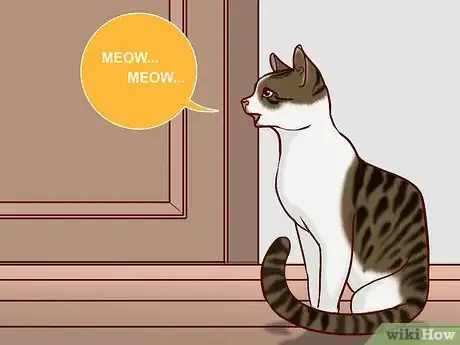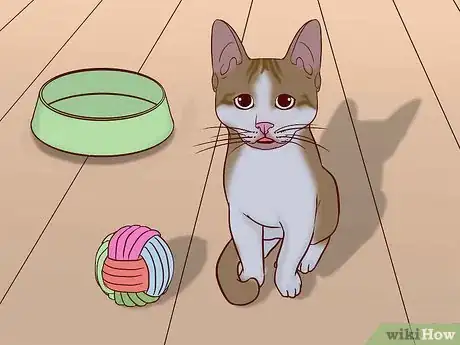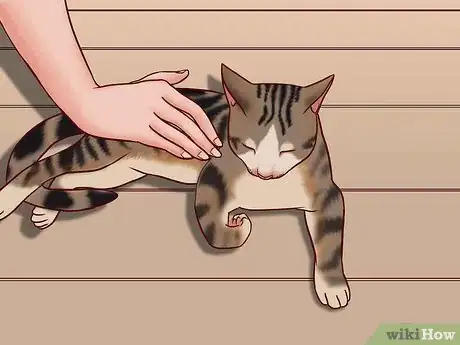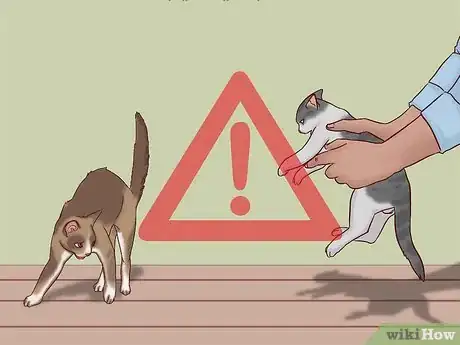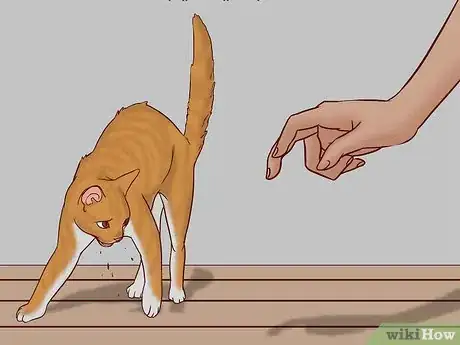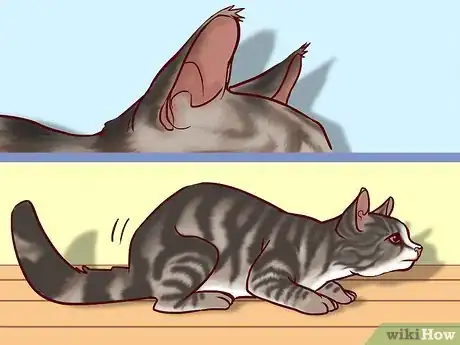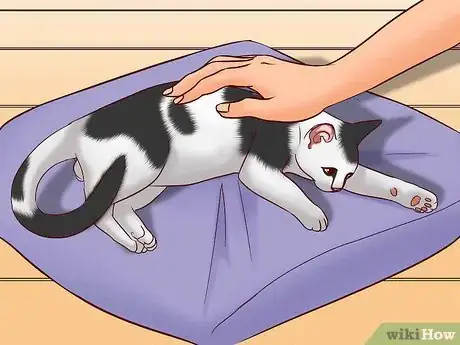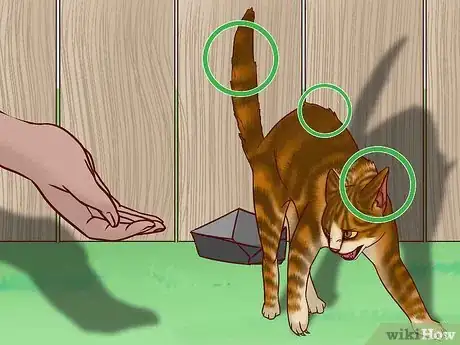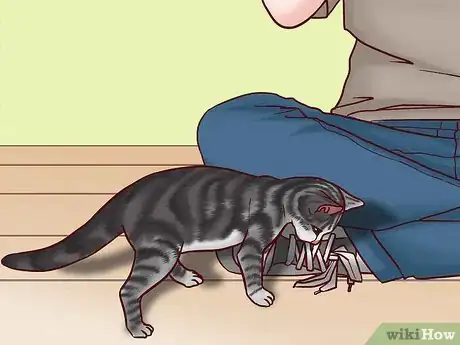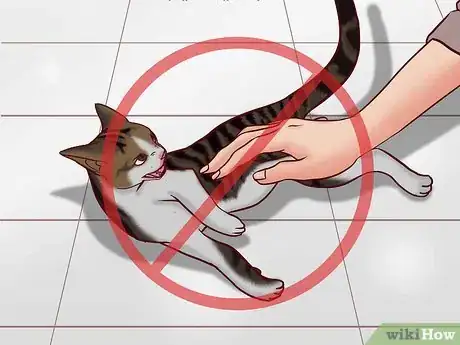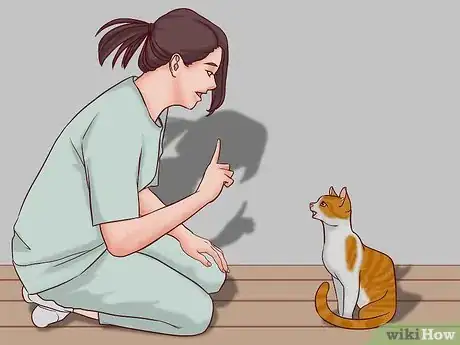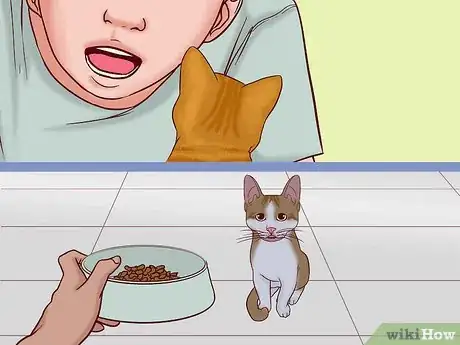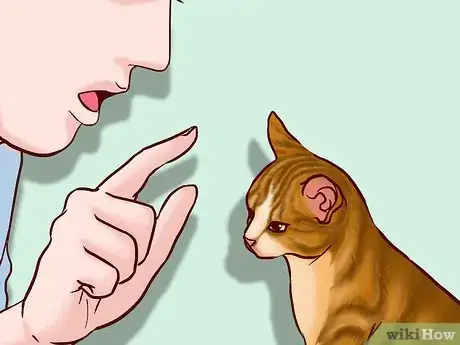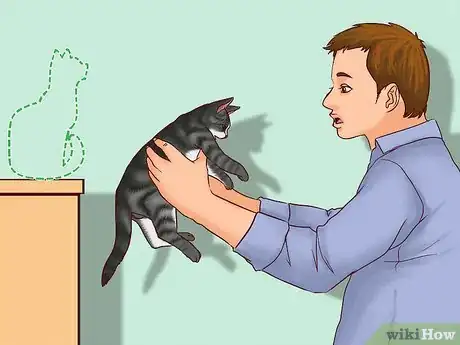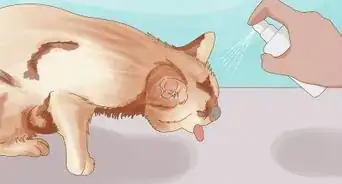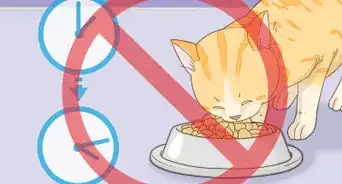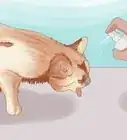This article was co-authored by Molly DeVoss. Molly DeVoss is a Certified Feline Training and Behavior Specialist (CFTBS), a Certified Cat Behavior Consultant (CCBC), a Fear Free Certified Trainer (FFCT), and the Founder of Cat Behavior Solutions. Molly specializes in using positive reinforcement to modify and prevent unwanted behaviors in cats and reduce cat shelter surrender. Molly has sat on the Dallas Animal Advisory committee since 2013 and was voted one of the Top 12 Extraordinary Cat Behaviorists of 2020 by Catpetclub.com. She is certified by both the Animal Behavior Institute and the International Association of Animal Behavior Consultants. She is also the host of the weekly podcast Cat Talk Radio.
This article has been viewed 31,948 times.
Cats are generally low-maintenance and fun pets to have in your house. Your cat can communicate with you by meowing, hissing, purring, and even moving its body to signal wants, needs, and emotions. You can learn more about these noises and cat body language to understand what your cat is “saying” and respond to them with touch or words.
Steps
Deciphering Cat Noises
-
1Pay attention to vocal meows to know when the cat needs something. If the cat meows loudly 1-2 times, assume that it wants you to do something for it. Try giving it food, water, and attention. For an outdoor cat, open the door to let them go outside or come inside. If the cat continues to meow, inspect their body to make sure they aren’t injured or in pain.[1] [2]
- The louder the meow, the more urgency the cat is trying to communicate.
- If kittens are meowing with their mouth open very wide, they may be signaling that it’s time to feed or that they feel scared.
Did you know? Cats often use meows to get their human to come to them. If your cat is meowing, try giving it some love and attention first!
-
2Listen for short yips, mews, and chirps, which mean the cat is happy. When you hear shorter, quieter noises from your cat, observe it to see what it's doing. These are normally signs that it wants you to know that it’s there and might want you to follow it somewhere. Sometimes, chirps can mean that the cat is "hunting" something, like a bird or a cat toy.[3] Often, the cat just wants you to know that it’s excited![4]
- Cats will frequently make these noises when it’s time for food or when they are communicating with another animal.
Advertisement -
3Enjoy the cat’s purring, which signals friendliness and contentment. When you’re petting and playing with your cat, listen closely for a low, rumbling noise from their throat. Keep petting, playing, or feeding the cat in the same way, as this is a sign that they’re feeling happy and want it to continue.[5] [6]
- Once the purring subsides, it’s okay to remove your hand. Cats can easily become overstimulated, so be sure to pay attention to the noises that they make.
-
4Be alert when you hear loud, long growls, yowls, or wails. These sounds are signs that something is wrong with a cat. When you hear these noises, look at the cat's posture to see if it looks like it's in pain or scared. Wailing is often a signal that a female cat is in heat, so keep it indoors and away from male cats if you don’t want a litter of kittens.[7]
- If you have more than one cat, growling can be a sign that two cats are about to fight. Try to separate them as quickly as possible to prevent injury.
- Prolonged, repetitive yowling often occurs when a cat is in profound pain, and you should get medical help quickly. Since cats instinctively hide their pain to avoid predators, they might be seriously ill.
-
5Back away and stay quiet when a cat hisses or spits. When a cat is threatened, they will pull back their gums to show their teeth and make a hissing noise. If you see this occur or feel the cat begin to spray saliva, remove yourself from the immediate area, preferably out of the cat’s sight. Often, the cat will stay where it is and gradually calm down.[8]
- Never try to pick up or touch a hissing cat. It can bite and scratch you, which can cause serious injuries.
Understanding Cat Body Language
-
1Play with the cat when its ears are forward and it’s crouching. When a cat is feeling playful and excitable, it will crouch on its front legs and flick its tail.[9] Use toys, a string, or a feature to lure the cat into pouncing, running, or pawing to play. Keep playing until the cat walks away or begins to use their claws.[10]
- Keep in mind that when a kitten is learning how to play, it will often bite and scratch to see what it can get away with, since it doesn't know what will hurt you.
Tip: If the cat is being too rough while you’re playing, mimic the sounds of a hurt cat by loudly yowling or wailing. This will signal to the cat that it’s hurting you and that it needs to be more gentle. If it continues to be rough, walk away from the cat to signal the end of play time.
-
2Pet the cat when it’s lying down with its tail still and ears pointed forward. Observe your cat by looking at its posture as it lays on its stomach or side. If the eyes are partially closed and the cat is being still, run your hand along the top of its head and its back. If the cat stays in one place, try petting its sides, face, and tail to see how it responds.[11]
- If the cat shrinks away from your touch or gets up, stop petting it. It may be trying to take a nap!
-
3Look at the cat's eyes to see if it's relaxed and content. When a cat squints or closes its eyes, this is a sign of happiness and relaxation.[12] Watch your cat's eyes as you pet them to see where they like to be scratched. If you want to tell your cat that you love them, you can even squint your eyes at them as a form of communication.[13]
- When you squint at your cat, try moving your head from side to side. Sometimes, if the cat is happy and relaxed, it will mimic your movements to show you that it understands what you're saying.
-
4Keep away from a cat with flattened ears or fluffed fur. Cats use their ears and fur to signal when they’re hunting, threatened, or irritated. Look at the ears to see if they’re pointed straight out to the sides or toward the back of the head. If the cat's back and tail fur is standing on end, slowly move away to make sure they aren’t frightened or threatened, which can cause them to attack.[14]
- Many cats will fluff their hair when they’re momentarily frightened, especially by loud noises. If your cat looks scared, try to find the object that they’re looking at and remove it from their sight.
-
5Allow the cat to rub against you to mark you with their scent. When you first enter into a cat’s territory, it may approach you. Stand still for a moment to allow it to rub against your legs, hands, and clothing, which makes you smell more like them. This is particularly important for indoor cats, because the outside can smell unusual and threatening to them, causing stress.[15]
- Cats can also accomplish this by rubbing their face against your hands while you pet them.
-
6Avoid petting the cat’s stomach, even if it’s laying on its back. If you come across a cat laying on its back with its stomach and paws in the air, try scratching its head or sides. A cat shows its stomach as a sign of trust, and if you touch it, it might claw or bite you to signal that you broke its trust.[16]
- Your cat may show you its stomach to say hello when you come home from work or to greet a new visitor.
Speaking to a Cat
-
1Be consistent about the tone and gestures that you use to communicate. Unlike dogs, cats aren't likely to respond to verbal commands alone, so rely on your tone, facial expressions, and hand movements to to talk to your cat. If you change your tone or gestures, this can confuse the cat and make communication more difficult.[17]
- When dealing with kittens, remember to exaggerate your emotions so they can easily understand when you’re reacting positively or negatively.
-
2Talk in a high-pitched, happy voice when praising or feeding the cat. Associate positivity with feeding, play time, and petting. Speak in a clear, cheerful voice and make eye contact with the cat so it knows you’re speaking to it. If the cat is resting, keep your voice quieter but still happy and positive.[18]
- Since cats have large ears, they tend to be more sensitive to loud noises. If you frequently have to yell to get your cat’s attention, take the cat to the vet to have its hearing checked.
-
3Speak in a firm voice when correcting the cat’s behavior. Use an authoritative, louder voice when the cat does something that isn’t allowed. Say “No!” or “Down!” to alert your cat that you’re displeased with a negative tone.[19]
- In general, try to use the same words when you’re disciplining the cat. Using too many or long words can be confusing.
-
4Couple words with touch to communicate with your cat. When you’re praising the cat, try petting its fur and speaking in a high voice to associate that tone with a positive experience. If you’re correcting a behavior, carefully move the cat away from the place where it misbehaved as you say “No” or “Down” in a stern tone.[20]
- Never discipline a cat by harming it. This is ineffective and can seriously hurt the cat.
Warnings
- When interacting with a cat that isn’t your own, always present an outstretched hand for it to smell before trying to pet it. If the cat seems threatened, move away and don’t try to touch it.⧼thumbs_response⧽
References
- ↑ Molly DeVoss. Certified Feline Training and Behavior Specialist & Certified Cat Behavior Consultant. Expert Interview. 28 June 2021.
- ↑ https://www.cathealth.com/behavior/how-and-why/1207-translating-cat-talk
- ↑ Molly DeVoss. Certified Feline Training and Behavior Specialist & Certified Cat Behavior Consultant. Expert Interview. 28 June 2021.
- ↑ https://www.cathealth.com/behavior/how-and-why/1207-translating-cat-talk
- ↑ Molly DeVoss. Certified Feline Training and Behavior Specialist & Certified Cat Behavior Consultant. Expert Interview. 28 June 2021.
- ↑ http://www.pawschicago.org/news-resources/all-about-cats/understanding-cat-behavior/translating-feline-body-language/
- ↑ https://www.cathealth.com/behavior/how-and-why/1207-translating-cat-talk
- ↑ http://www.humanesociety.org/animals/cats/tips/cat_communication.html
- ↑ Molly DeVoss. Certified Feline Training and Behavior Specialist & Certified Cat Behavior Consultant. Expert Interview. 28 June 2021.
- ↑ http://www.humanesociety.org/animals/cats/tips/cat_communication.html
- ↑ http://www.humanesociety.org/animals/cats/tips/cat_communication.html
- ↑ Molly DeVoss. Certified Feline Training and Behavior Specialist & Certified Cat Behavior Consultant. Expert Interview. 28 June 2021.
- ↑ https://www.cats.org.uk/help-and-advice/cat-body-language
- ↑ http://www.humanesociety.org/animals/cats/tips/cat_communication.html
- ↑ https://www.cats.org.uk/help-and-advice/cat-body-language
- ↑ https://www.cats.org.uk/help-and-advice/cat-body-language
- ↑ https://www.catster.com/cat-behavior/how-to-talk-to-your-cat
- ↑ https://www.catster.com/cat-behavior/how-to-talk-to-your-cat
- ↑ https://www.catster.com/cat-behavior/how-to-talk-to-your-cat
- ↑ https://www.catster.com/cat-behavior/how-to-talk-to-your-cat
About This Article
To speak to your cat, use a high-pitched, happy voice when you want to praise it for good behavior or whenever you're petting or playing with it. If your cat does something that it's not supposed to, use a loud, firm voice to show that you're displeased. To understand what your cat wants based on the noises it makes, listen carefully to how long its meows are. If they're short, it's a sign that your cat is happy and content. If they're long and drawn out, it could be a sign that your cat is upset or in pain. To learn how to understand cat body language, scroll down!
